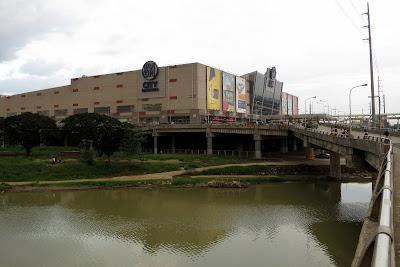31 October 2012
Cebu Weekend
While no match to Sandy, we were worried Thursday
evening that the heavy rains from tropical storm Ofel would impede our weekend
trip to visit Fritz’s old college roommate, Hui. Hui had a long weekend
off from her job in Singapore and flew over to meet us near Cebu. We
stayed at Talima on Olango Island, a 20 minute boat ride from Mactan Island,
home to Cebu’s airport. Despite Talima’s good service and beautiful view, we were a bit
disappointed at its isolation and lack of walking opportunities.
We had a friend working in Cebu
for the week and decided to spend Saturday exploring the city with her.
We met our friend, Ging, in late morning near an office park and she asked
us if we wanted to explore Cebu as tourists or locals. We opted for the
locals’ tour and followed her lead for the rest of the day. We began with
an inasal barbeque lunch. (Cebu
is known for having better food than Manila.) Inasal refers to the sauce
used to marinate and grill bamboo skewers of fresh meat. We selected our
desired partially-cooked cuts of meat—four chicken legs and a fish—and returned
to our table while the cooks gave the skewered food a second grilling.
Ging also ordered us a plate of puso—fist-sized portions of steamed rice
cooked in woven strips of palm leaves—and a delicious bowl of beef and leek
soup. Our waitress brought over our order of bright red, perfectly
charred chicken and fish and we dug in…definitely the tastiest meat we’ve had
in the Philippines. While we still gushing over our delicious lunch, Ging
led us a kilometer up the road to Fudge, a gourmet dessert shop, to cap off the
meal.
Sufficiently satiated and
completely trusting Ging, we hopped on the backs of two motorcycles.
Before we realized what we had gotten into, Fritz and I were hugging our
motorcycle driver closely as we curved up the side of a mountain through the
coolest air we’ve felt since our arrival. After twenty minutes we hopped
of our motos and walked through an entrance straight out of The Hobbit
to see a breathtaking view of Cebu, Mactan, and Olango islands along with the silhouettes
of other provinces. We waited for a brief shower to pass over before
riding on the motos back down the mountains to catch our boat on Mactan back to
Olango. We boarded our Olango-bound Bangka a little after 5pm and
soon into our ride we were caught in the middle of windy rainstorm. We
could no longer see Olango and the sun had almost set for the day, but the
storm moved through quickly and we safely made it back to Talima for the night.
We had another tasty dinner at
Talima: green mongo bean and coconut milk soup with ginger. We’re still
asking around for a local recipe to replicate. Sunday morning we set out on tricycle for bird watching at Olango Island Wildlife Sanctuary. Our guide,
Socrates, was a wealth of information and helped us identify 18 different species of birds,
including the very rare Asian Dowitcher and Chinese Egret. Here are the various
birds we saw:
Asian Dowitcher (think we saw 9 of these)
Little Egret
Whimbrel
Far Eastern Curlew
Common Redshank
Common Greenshank
Bar Tailed Godwit
Great Knot
Chinese Egret (saw two of these running around and feeding, really fun to
watch since they basically were dancing around the sand)
Gullbilled Tern
Common Tern
Rufous Necked Stint
Mongolian Plover
White Collared Kingfisher
Pacific Swallow
Ruddy Turnston
Grey Plover
Rufous Night Heron (there was one of these that hung out near the main
building and was pretty much tame)
When we walked out along the path around 9am as high tide was coming in,
all of the stones were above water. When we returned two hours later, all
but the first few were submerged. As impressed as we were at watching the
tide come in, it seems so insignificant now after watching Sandy’s destruction.
We packed up in early afternoon to return to Cebu’s airport and were home
around 9pm Sunday evening—another busy yet worthwhile weekend.
 |
| Big tuko gecko helped keep away bugs in our hotel room |
 |
| people parasailing in strait between Olango and Mactan islands |
 |
| stairs from Talima down to ocean where we would board the bangka |
 |
| Talima |
 |
| little hermit crab hanging out in Talima |
 |
| one of the many bangkas we could see from Talima |
 |
| amazing inasal lunch in Cebu with Ging and Hui |
 |
| looking down towards Cebu from Busay |
 |
| Cebu, Mactan island behind it |
 |
| rain coming in |
 |
| lots of orchids tied to trees in wildlife sanctuary |
 |
| walking out to viewing station. Lots of fish and crab activity in water around walkway |
 |
| with Socrates, the guide |
 |
| tide starting to cover walkway back to shore |
 |
| Using Socrates' scope to look at dozens of birds pushed together as the tide rises. They were too far away to photograph with my camera. |
 |
| heading back as tide rises |
 |
| viewing station. Saw almost 20 different species of birds from this one spot |
 |
| tame rufous night heron |
 |
| some of the larger crabs that were hanging out on the rocks |















